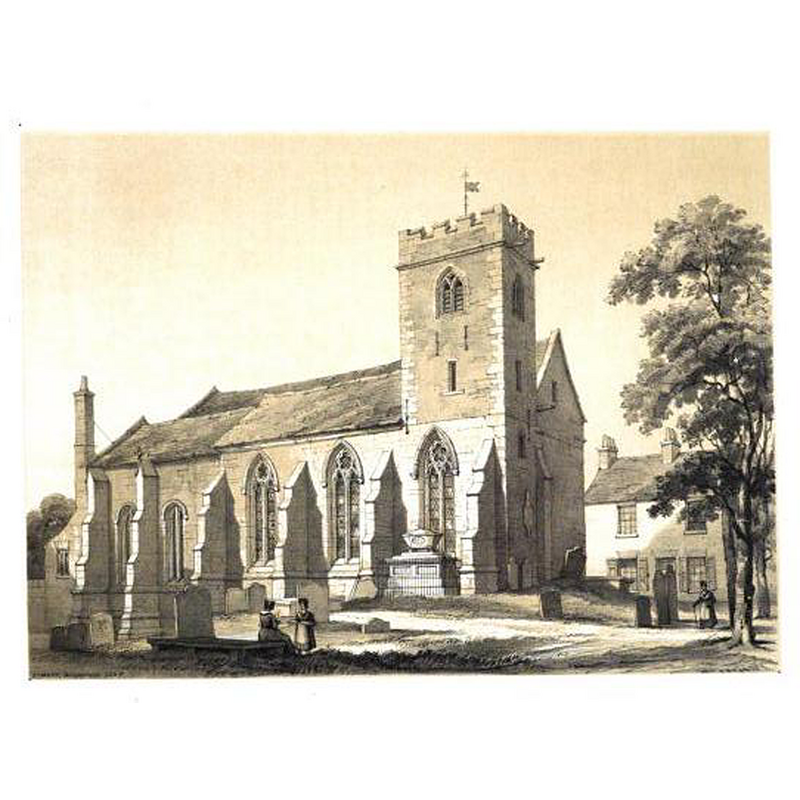York No. 26, Bishophill Senior / Eboracum / Eburacum / Eburākon / Eoforwic / Everwic / Jórvík

Image copyright © [in the public domain]
PD
Results: 2 records
view of church exterior in context - northwest view
Scene Description: view of the church in the mid-19thC; said to date originally to late-Saxon times, it had been much modified through the centuries; it was demolished in the 1960s -- William Monkhouse was an illustrator, lithographer and publisher. The Grove Encyclopedia of Medieval Art and Architecture (vol. 5: 42) gives dates 1813-1898 for Monkhouse, and informs that Beford worked as a lithographer alongside Monkhouse; Fawcett annotated the volume on York churches
Copyright Statement: Image copyright © [in the public domain]
Image Source: digital image of an illustration in William Monkhouse, Francis Bedford and Joshua Fawcett's Churches of York (York: H. Smith, 1843)
Copyright Instructions: PD
INFORMATION
FontID: 14050YOR
Object Type: Baptismal Font1 (fragment)
Church/Chapel: Parish Church of St. Mary, Bishophill Senior [aka Bishophill the Elder] [demolished 1960s]
Church Patron Saints: St. Mary the Virgin
Church Location: address and coordinates for the site of the demolished church: 24-48 Hampden St, York, UK
Country Name: England
Location: North Yorkshire, Yorkshire and the Humber
Directions to Site: It was located in Bishophill, to the SE of Micklegate Bar [demolished in 1963]
Ecclesiastic Region: [Diocese of York]
Historical Region: Hundred of York
Font Location in Church: [cf. FontNotes]
Century and Period: 13th century (late?) [fragment], Medieval [composite]
Font Notes:
Click to view
There are twelve entries for York in the Domesday survey [https://opendomesday.org/place/SE6052/york/] [accessed 8 August 2019] eight of which mentions a church in it [cf. infra]. The entry for this church in Monkhouse, Bedford & Fawcett (1843) notes: "The Font is DEC[orated], 8-gonal, basin 8-gonal, stem and square base". The entry for this parish in the Victoria County History (York, 1961) notes: "The church of ST. MARY, Bishophill, Senior, is first mentioned in 1202 [...] In 1876 the newly built church of St. Clement was substituted for St. Mary's as parish church. The substitution was made without consultation of the parishioners and aroused much ill feeling. The parish boundaries were revised in 1885 so that the church lay in Bishophill Junior parish. It was still used for occasional services in 1919. In 1956 it was ruinous and a faculty was then obtained for its demolition, but in 1958 the ruins were still standing." The RCHM (York, 1962- ) notes: "Font: fragment found in 1964, with Geometrical panelling, late 13th-century." St. Mary Bishophill Senior was one of the earliest churches of York, already in place in the early 11th century. According to th RCHM (ibid.) and Butler (2007) it was demolished in 1963. The entry for the cemetery of this church in Find a Grave [www.findagrave.com/cemetery/2500907/st-mary-bishophill-senior-churchyard] [accessed 22 August 2019] notes: "The now demolished St. Mary Bishophill (Senior) Church dated to before the Norman conquest times, and had a nave which was of a late Saxon date, and the church was also recorded in the Domesday Book. An aisle was added in the twelfth century and a doorway from the same period which survived until the church was demolished in the 1960s. It has also been discovered that there were also some Roman walls situated underneath the church. [...] The church was sadly demolished in 1963 and some of the fittings were moved to St. Clement's Church on Scarcroft Road and the arcade was incorporated into the Church of the Holy Redeemer on Boroughbridge Road." [NB: we have no information on the fate or whereabouts of the original font of this church]
COORDINATES
Church Latitude & Longitude Decimal: 53.955211, -1.085622
Church Latitude & Longitude DMS: 53° 57′ 18.76″ N, 1° 5′ 8.24″ W
UTM: 30U 625614 5980235
MEDIUM AND MEASUREMENTS
Material: stone
Font Shape: octagonal (mounted)
Basin Interior Shape: round
Basin Exterior Shape: octagonal
REFERENCES
Victoria County History [online], University of London, 1993-. Accessed: 2019-08-27 00:00:00. URL: https://www.british-history.ac.uk.
Glynne, Stephen Richard, The Yorkshire notes of Sir Stephen Glynne (1825-1874), Woodbridge: The Boydell Press; Yorkshire Archaeological Society, 2007
Great Britain. Royal Commission on Historical Monuments (England), An Inventory of the Historical Monuments in the city of York, London: H.M. Stationary Office, 1962-
Monkhouse, William, The Churches of York [...] with Historical and Architectural Notes [...], York: H. Smith, 1843

